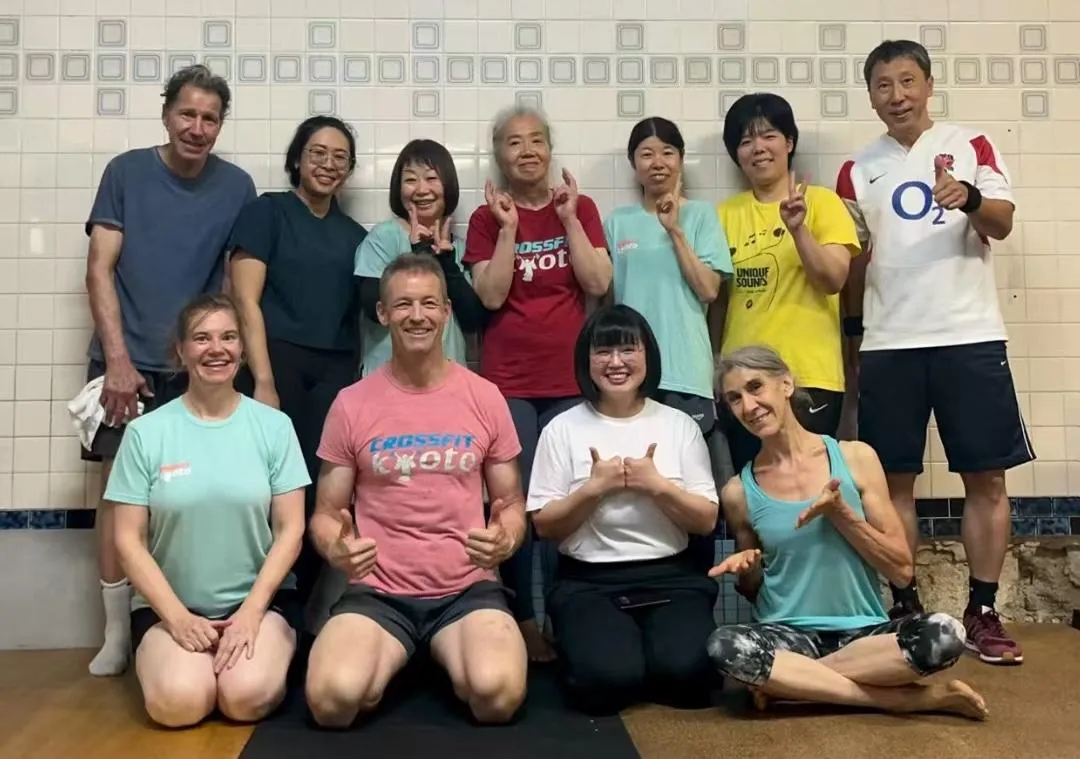
Kyoto, On a Layover: When Systems Age
I went to Kyoto last week for a flight transfer and decided to stay a few days. I wanted quiet—enough space to think about work and life without the usual velocity. Kyoto rewards slowness. The streets are disciplined, the green feels intentional, the old is preserved without apology.

I wrote to my old friends, Ela and Russel, owners of CrossFit Kyoto. Their box has been open fifteen years—an eternity in the fitness world. We’ve known each other six or seven years (they swear it feels like ten). I offered to coach while I was in town. This time they didn’t ask for weightlifting. They asked for health-focused alignment sessions. I was fine with either. I was curious how people here would respond.
CrossFit Kyoto sits inside what used to be a public bath. The shell remains: the clean lines, the feeling of shared ritual embedded in the walls. Everything is so tidy that my first reflex was to take my shoes off at the door. The space carries order but not stiffness.

We ran two sessions—upper-body alignment, then lower-body alignment. I wondered whether this slower, more precise work would land with the group. The room answered for me. The atmosphere was lively and light, a little restrained in the way Kyoto often is, but unmistakably happy. You could see it in the small wins. Someone squatted two centimeters deeper and laughed, surprised at their own hips. A shoulder freed and the breath changed. People don’t need speeches when structure gives way—relief speaks for itself.
A woman in her seventies stayed with the entire shoulder session. At the end her arms hung differently—less noise around the joint, more space for movement. She smiled. So did I. Aging doesn’t forbid adaptation; it makes the stakes clear.

Later, over tea, Ela and Russel caught me up. The pandemic hit their business first through the economy and then through confidence. After that, their only coach left to open a new box and took around twenty younger men with him—the ones who wanted to train heavy and be loud about it. What remained was an older, steadier membership. Good people. Fewer headlines. More reality.
From outside, someone might frame this as loss. I don’t. I see an audit.
Every system ages. If it lasts long enough, its founding choices get tested. CrossFit—any intense training culture, really—grew on youth, novelty, and the charisma of individual coaches. That growth engine is powerful and fragile. Youth moves on. Novelty expires. Charisma is not a structure.
The body tells the same story. After ten to fifteen years of hard training, the questions change. “How much can I lift today?” turns into “How long can I move without paying for it later?” “Can I PR?” turns into “Can I sleep?” This isn’t surrender; it’s recognition. The currency shifts from spectacle to continuity.
There is also a knowledge gap. Most people—athletes included—carry small dysfunctions and train around them. They are never taught enough anatomy or biomechanics to see what hurts them. They add capacity on top of compensation, proud of numbers earned in poor positions. Pain accrues invisibly until it doesn’t. When that bill arrives, it feels like betrayal. It isn’t. It’s accounting.
Kyoto throws the contrast into focus. Outside: temples that have endured for centuries because they were built to be maintained, not merely admired. Inside: a gym facing mid-life questions after fifteen years because it was built around intensity and a single coach’s gravity. The city is a lesson in continuity. The gym is a lesson in dependency.
None of this is “a Japanese problem.” Japan’s demographics just accelerate the reveal. The same audit is scheduled everywhere. As early CrossFit adopters hit their second decade, communities will split: some will chase the next hard thing; others will choose to move well enough to move longer. Both paths are honest. Only one survives time.
If you coach, the questions are simple and uncomfortable:
What part of your business fails if one person leaves?
What training beliefs still exist because they’re loud, not because they’re true?
Can your programming absorb aging without turning into nostalgia or denial?
What do your members know about their bodies beyond slogans and effort?
If you train:
Which pains have you normalized because they let you keep your identity?
What do you do today that your sixty-year-old self will thank you for?
Where are you chasing short-term satisfaction against long-term function?
Kyoto helped me see this without drama. The city doesn’t brag. It maintains. The people in those sessions didn’t posture. They attended to their bodies. The seventy-year-old didn’t ask for permission. She trained. The joy in the room wasn’t the high of spectacle; it was the relief of function returning.
Aging is not the enemy. It is the audit. It shows what was fragile from the start and what can be strengthened now. It asks whether our systems—gyms, bodies, businesses—were built to be maintained or just admired.
I left Kyoto the way I entered: briefly, between flights. But those few days did their work. The quiet streets and the bathhouse-turned-gym lined up the same question in different languages: When the rush is gone, what remains?
Not the numbers on a whiteboard.
Not the story about who left and who stayed.
Not the mood of a single coach.
What remains is what you can maintain—what you can keep showing up for without breaking. Build that.

PS: If you ever find yourself in Kyoto and love weightlifting or CrossFit, make time for Ela and Russel’s CrossFit Kyoto. The space itself is unique, the atmosphere grounded, and the couple are as kind as they are dedicated. If you drop by, say hello for me.
